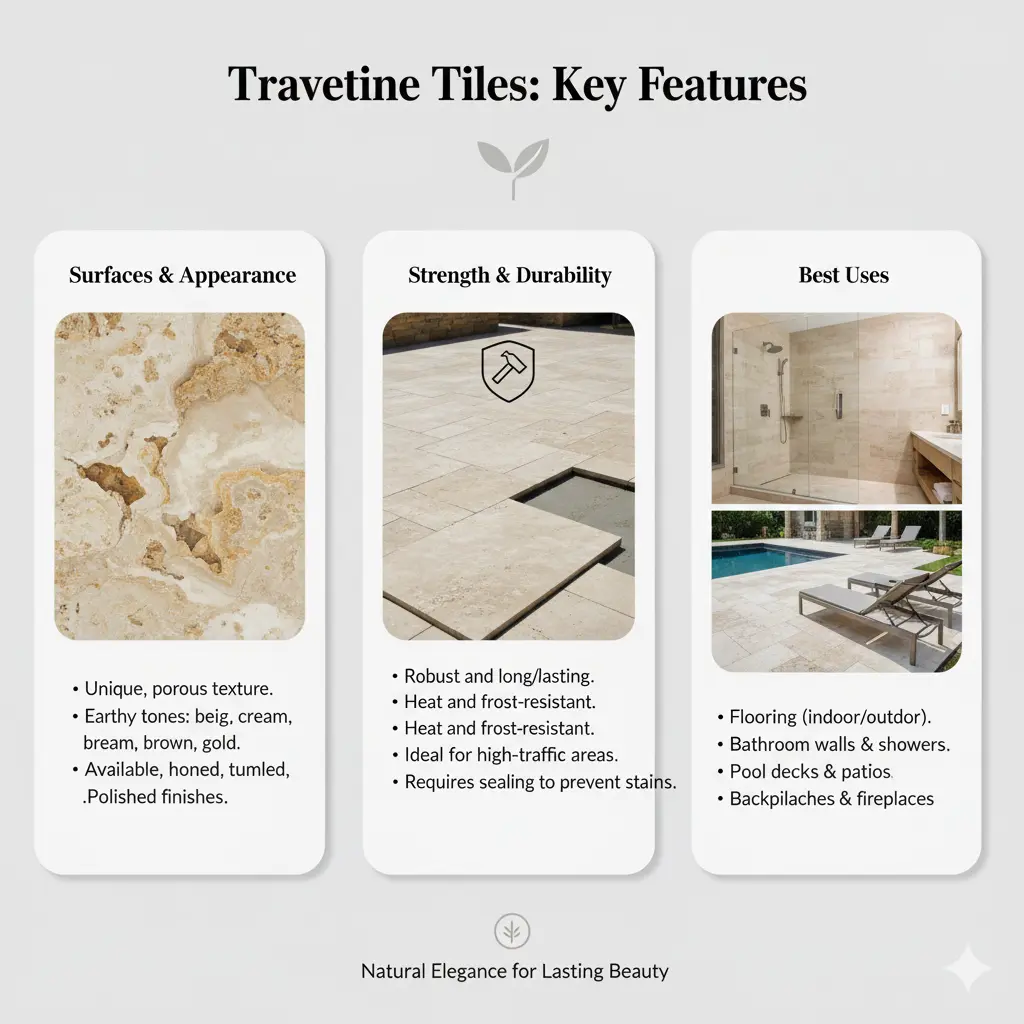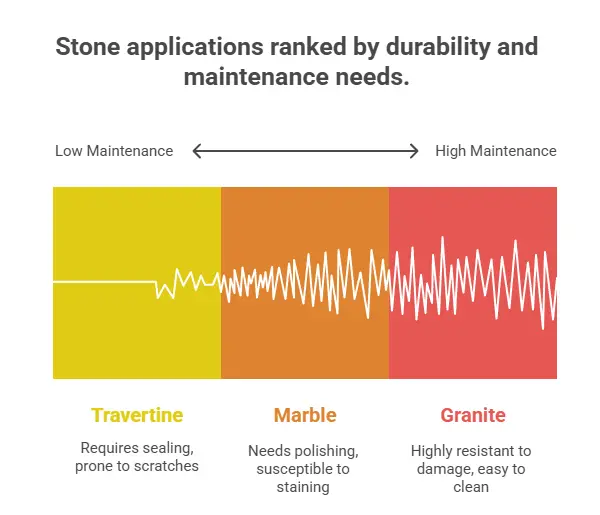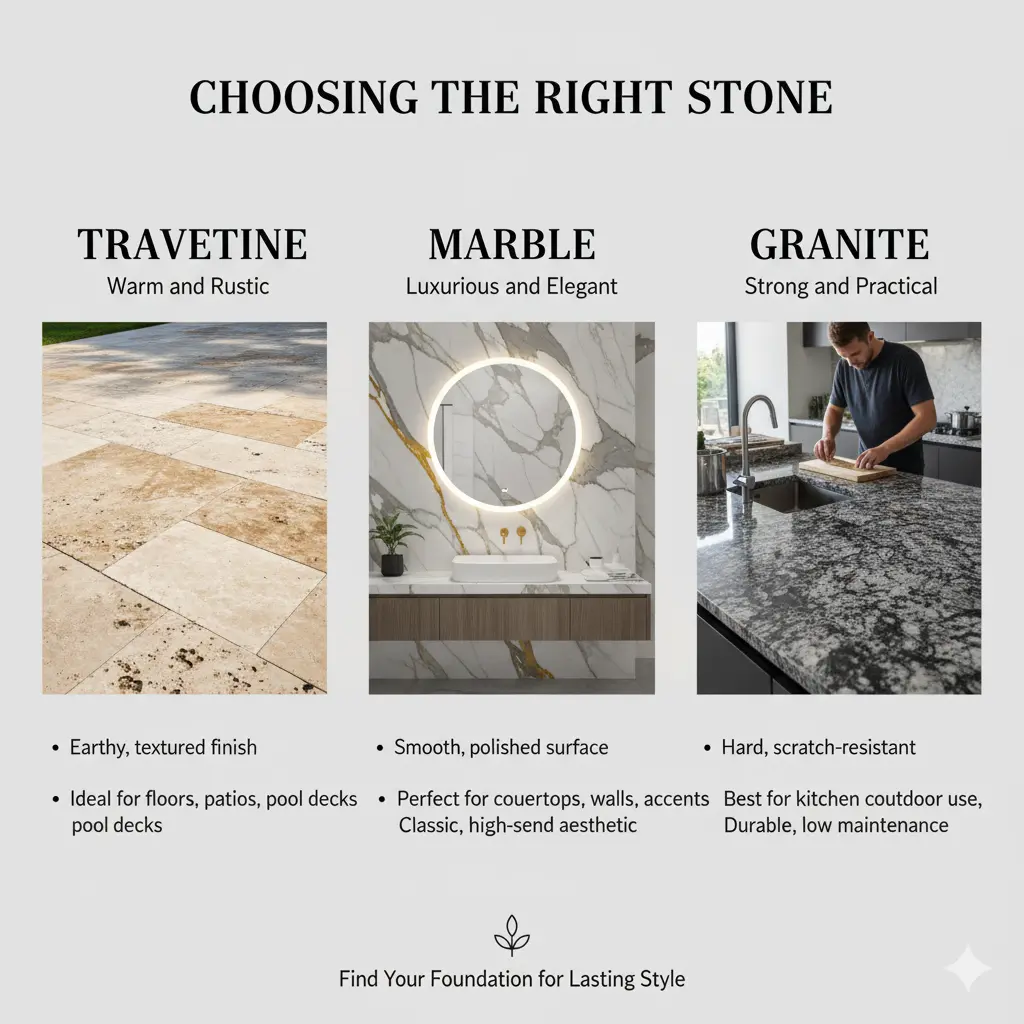2 October, 2025

Introduction
Natural stone, including marble tile, travertine tile, and granite tile, has been admired for centuries as both a building material and a design element. In modern residential spaces, it brings timeless elegance, unmatched durability, and a sense of luxury to homes and commercial uses. Choosing the right type of tiles is more than an aesthetic decision it impacts durability, maintenance, and overall aesthetic appeal.
It is important to choose travertine tiles for their classic beauty and durability, making them an ideal option for both residential and commercial application.
Whether you’re designing bathrooms, shower walls, or expansive floor areas, picking the right stone travertine tile, marble, or granite will set the right vibe for your project.
Understanding Natural Stone Tiles
Unlike synthetic options, real stone such as limestone, travertine tile, marble tile, and granite tile is extracted in large blocks from quarries and cut into slabs, pavers, or mosaic formats. Travertine, for example, is quarried in regions such as Turkey, Italy, and the US, with characteristics of the stone varying depending on the specific quarry. These materials are prized for their distinctive texture, timeless appeal, and refined charm.
Among the many choices, travertine floor tiles, marble tiles, and granite tiles dominate the market. Each has versatile applications across walls, backsplashes, patios, and kitchen tops.
Key characteristics:
-
Texture & Surface: Matte surface, polished, honed, or brushed finishes
-
Strength & Durability: From visibly porous to scratch-resistant
-
Maintenance needs: Sealing, cleaning routine, resilience in wet areas
-
Cost considerations: From affordable to premium stones
Natural Beauty of Stone
The natural beauty of stone is unmatched, making it a favorite among designers and homeowners alike. Marble tile, with its elegant surface and distinct veining, brings a sense of sophistication and elegant to any space. Each piece of marble is unique, ensuring that no two marble floor tiles are ever exactly the same, which adds to their Visual appeal. Travertine floor tiles, on the other hand, are celebrated for their truly distinctive texture characterized by a visibly porous, pocked surface that feels both organic and inviting. This textured look is especially striking in outdoor spaces, where travertine tiles can transform pool decks and corridors into stunning, slip-resistant areas that blend seamlessly with the natural environment. Whether used as floor tiles indoors or as a feature in outdoor living areas, the beauty of stone like marble and travertine creates enduring charm that elevates any project.
Travertine Tiles Explained

Travertine tiles is a type of limestone formed around mineral springs. Known for its pocked surface and visibly porous structure, it’s often available in tumbled finish, brushed or honed finish to balance rustic and modern styles.
Different finishes and filling techniques make travertine especially suitable for interior flooring, wall coverings, and decorative elements, highlighting its versatility and appeal in interior design.
Travertine has been used in architecture around the world for centuries, contributing to its reputation as a timeless material.
Key Features:
-
Surfaces & Appearance: Travertine has a naturally matt surface, earthy beige, cream, and grey shades, and a truly distinctive texture that adds rustic charm to outdoor spaces.
-
Strength & Durability: Softer than granite but resilient with proper sealing. Performs well in warm climates and high traffic areas.
-
Best Uses: Perfect for pool decks, patio, bathrooms, and shower walls. Indoors, it adds timeless beauty to living spaces.
-
Pros: Affordable, Long-lasting material, naturally warm, slip-resistant in wet areas.
-
Cons: Needs regular sealing, prone to stains if left untreated.
Marble Tiles Explained
Marble, often extracted in Italy and other regions, is celebrated for its classic style and distinct veining. Marble tile is a versatile and elegant material used in kitchens, backsplashes, and flooring, valued for its historical significance.
Key Features:
-
Surfaces & Appearance: Known for distinct veining and smooth polished, brushed or smooth finish.
-
Available in mosaic, slabs, and tiles.
-
Strength & Durability: Softer than granite, susceptible to etching from acidic substances, and can stain without sealing.
-
Best Uses: Ideal for bathrooms, kitchen backsplashes, hotel lobbies, and residential entryways.
-
Pros: Timeless appeal, unique patterns, enhances property value.
-
Cons: Higher maintenance, less resistant to high traffic areas.
Granite Tiles Explained
Formed deep within the earth, granite is one of the hardest real stones available. Extracted from global quarries, it has been prized in Italy and beyond for strength and durability.
Key Features:
-
Surfaces & Appearance: Recognized for its speckled texture, crystalline sparkle, and modern look. Available in polished, brushed, or smooth finishes.
-
Strength & Durability: Resistant to high temperatures, scratches, and water. A durable option even in busy areas.
-
Best Uses: Frequently chosen for kitchen tops, commercial flooring, outside areas, and pavers.
-
Pros: Extremely durable, low maintenance, withstands elements.
-
Cons: Heavier and costlier than travertine.
Timeless Elegance of Natural Stone
Natural stone, such as marble tiles and travertine tiles, is renowned for its simple grace and versatility. Marble tiles, with their polished or smooth finish, offer a classic look that suits both modern and ornate interiors. The smooth, reflective surface of polished marble adds a sense of luxury, while the satin finish provides a more understated, matte surface that exudes quiet sophistication.
Travertine tiles, with their honed finish and subtle color variations, bring a rustic yet refined charm to residential spaces, making them the perfect choice for those seeking warmth and character. Whether used for flooring, walls, raw stone is a long lasting material that adapts beautifully to a variety of design styles. Its enduring appeal ensures that spaces featuring marble or travertine remain stylish and inviting for years to come.
Travertine vs Marble vs Granite: Side-by-Side Comparison
| Feature | Travertine | Marble | Granite |
|---|---|---|---|
| Visual Appeal | Rustic, earthy, warm tones | Elegant, veined, timeless beauty | Modern, speckled, crystalline |
| Texture | Porous, tumbled, matte | Smooth, polished or honed | Crystalline, brushed or polished |
| Durability | Good, needs sealing | Moderate, delicate to stains | Highest, excellent in moist areas |
| Maintenance | Regular sealing required | Sensitive to etching & stains | Easy to clean, minimal sealing |
| Cost | Affordable | Mid-range | Premium, varies by quarry & origin |
| Installation | Easy to cut, requires sealing | Requires skillful installation | Heavy, complex cutting |
Applications of Travertine, Marble, and Granite

Natural stone is valued not only for its beauty but also for its versatility across different areas of the home and outdoors. Each type travertine, marble, and granite has unique strengths that make it suitable for specific applications:
Travertine Applications
-
Floors & Walls: Warm tones and rustic texture make travertine ideal for living spaces, hallways, and bathrooms.
-
Outside Areas: Slip-resistant surface perfect for pool areas, patios, and garden paths.
-
Bathrooms & Showers: Honed or tumbled travertine tile add elegance to wet areas.
Marble Applications
-
Luxury Flooring: Marble floor tiles bring classic style to foyers, dining rooms, and lounges.
-
Kitchen tops & Vanities: Polished marble creates a refined surface for kitchens and bathrooms.
-
Feature Walls: Dramatic distinct veining makes marble ideal for statement walls.
Granite Applications
-
Kitchen Top: Durability and resistance to heat, scratches, and stains.
-
High-Traffic Floors: Perfect for commercial spaces.
-
Outdoor Use: Long-lasting performance in exterior cladding, steps, or garden features.
Installation of Travertine, Marble, and Granite
Proper installation and regular care are essential to keep real stone surfaces looking their best. Here’s what you need to know about each stone:
Travertine Tiles: Requires a clean, level base. Seal tiles before grouting; use non-acidic adhesive. Professional installation recommended.
Marble Tiles: Softer than granite; reinforced subfloor needed. Seal during installation for kitchen and shower walls.
Granite Tiles or Slabs: Heavy and dense. Professionals use strong adhesives and leveling tools. Countertops require reinforced cabinetry.
Maintenance of Travertine, Marble, and Granite
-
Travertine: Clean with mild, pH-neutral cleaners. Reseal every 1–2 years. Wipe spills immediately.
-
Marble: Use stone-safe cleaners. Reseal annually, especially in high-use areas. Protect from acidic substances.
-
Granite: Clean with soft cloth and mild cleaner. Seal every 2–3 years. Use trivets and boards to prevent scratches.
Cost Breakdown
-
Travertine floor tiles: Affordable, $5–$15 per sq. ft. depending on finish (tumbled, smooth finish, mosaic)
-
Marble floor tiles: Mid-range, $10–$25 per sq. ft. (Carrara may be higher)
-
Granite tiles: Premium, $15–$40 per sq. ft., varies by quarries, slabs, and thickness
-
Factors affecting cost: materials, rarity, surface finish, installation complexity, and regional project demands.
Sustainability & Eco-Friendly Considerations
Compared to engineered materials, real stone lasts for decades, reducing waste. Travertine, marble, and granite are long lasting materials that can be repurposed as pavers, walkways, or even backsplashes. Their durability means less frequent replacement, offering both environmental and long-term financial benefits.
Additional Considerations
When selecting natural stone tiles like marble tiles or travertine tiles, it’s important to consider factors beyond just appearance. Durability is a key consideration, especially in busy areas, bathrooms, or spaces exposed to high temperatures and moisture. Travertine floor tiles are known for their resilience and ability to withstand daily wear, making them a durable option for bathroom floors and walls.
Marble tiles, while stunning, require more frequent maintenance and sealing to protect against stains and spills. Additionally, the quarrying and sourcing of authentic stone can impact the environment, so choosing a supplier committed to sustainable and responsible quarrying practices is essential. By weighing these factors, durability, maintenance needs, and environmental impact homeowners can confidently select the right natural stone tile for their project, ensuring both beauty and longevity.
Choosing the Right Stone

When deciding between travertine tiles, marble floor tiles, and granite slabs, it’s important to consider not only aesthetics but also strength, maintenance, and budget. Each raw stone has its own strengths, making it better suited for certain applications.
Travertine : Warm and Rustic
-
Best for outdoor parking, bathrooms, and casual indoor spaces.
-
Offers earthy tones and a truly distinctive texture.
-
Requires sealing but provides good grip in moist areas.
-
Ideal for timeless, rustic charm at a moderate cost.
Marble : Luxurious and Elegant
-
Perfect for indoor flooring, countertops, and feature walls.
-
Famous for its distinct veining and polished look.
-
Requires more maintenance.
-
Best for a luxurious, refined atmosphere.
Granite : Strong and Practical
-
Excellent for kitchen countertops, commercial flooring, and outdoor cladding.
-
Extremely durable, scratch- and heat-resistant.
-
Needs sealing but less frequent than marble or travertine.
-
Ideal for low-maintenance, long-lasting uses.
Lasting Impressions
Choosing the right real stone tile can leave a lasting impression on any room, infusing it with warmth, elegance, and character. Marble floor tiles, with their sophisticated veining and polished finish, instantly elevate the look of a space, creating an atmosphere of refined luxury. Travertine tiles, with their distinctive texture and earthy tones, offer a cozy and inviting feel that makes any room more welcoming.
The key to making a lasting impression is to select floor tiles or wall tiles that not only complement your existing decor but also introduce unique features of natural beauty. Whether you opt for marble, travertine, or another raw stone, these materials provide a versatile foundation for stunning designs that stand the test of time. With their truly unique surface and enduring visual appeal, real stone tiles ensure your space remains both beautiful and memorable for years to come.
Expert Advice
When considering travertine floor tiles or marble tiles, think about the specific application, desired texture, and finish. Travertine is ideal for pool decks, walkways, and outdoor parking where both style and slip-resistance matter.
Marble floor tiles provide classic style for bathrooms, kitchens, or statement walls. Limestone is another excellent natural stone choice for flooring, walls, and countertops in modern or traditional settings.
Consult a professional for selecting the right stone, finish, and installation method. An expert can guide you on tumbled finishes for rustic outdoor spaces or polished marble for sleek interiors.
FAQs
1. Is travertine a real stone?
Yes, travertine is a genuine natural stone formed from limestone deposits. Its distinct texture and durability make it a popular choice for both indoor and outdoor applications.
2. Is travertine good for shower walls and bathrooms?
Yes, especially with a smooth finish or tumbled finish for slip resistance in moist areas.
3. Which stone is easiest to clean and maintain?
Granite, thanks to its resistance to stains and scratches.
4. Does granite stain more than marble?
No, marble is more prone to staining and etching.
5. Which stone adds more resale value to a home?
Marble adds luxury, while granite adds practicality and durability.
6. Is marble tile durable for flooring?
Yes, marble is durable and long-lasting, but it can be prone to scratching and etching, so sealing and proper care are recommended.
7. Does marble tile require sealing?
Yes, marble is porous and should be sealed regularly to protect against stains and moisture.
8. Is travertine tile good for outdoor use?
Yes, travertine handles outdoor conditions well, making it a great option for patios, pool decks, and garden paths.
9. Does travertine tile need sealing?
Yes, travertine is porous and should be sealed to prevent water absorption and staining.
Conclusion
Each stone travertine, marble, and granite offers unique texture, natural beauty, and durability:
-
Travertine: Rustic charm for backsplashes and pool decks.
-
Marble: Timeless elegance in bathrooms and living spaces.
-
Granite: Maximum durability for countertops, high traffic areas, and commercial areas.
The perfect choice depends on your space, lifestyle, and maintenance preferences. Consult tile experts for the best results with these timeless materials.